Venting Hoods: An Essential Partner for Your Range
If you’re a cooking connoisseur, then you understand that the right range hood can make all the difference in both function and style. If you consider yourself more of an everyday cook, this may be new territory. Yes, of course the hood should look good, but its primary job is to properly ventilate your space. As you balance style, function and budget, there are plenty of ventilation hood options to consider. Here are some things to keep in mind as you plan out the best venting solution for your new kitchen.
KNOW BEFORE YOU BUY
Your range or cooktop will dictate the type of ventilation hood required. Once you’ve selected your cooking appliance, talk with your designer or contractor about ventilation options that are compatible with your selection. Because ventilation codes and permit requirements vary from state to state and even from city to city, it’s important to check with local authorities or with a local HVAC professional if you have questions.
Make sure to finalize your appliance selection BEFORE placing your cabinet order.
Under-Cabinet Vent Hood
$
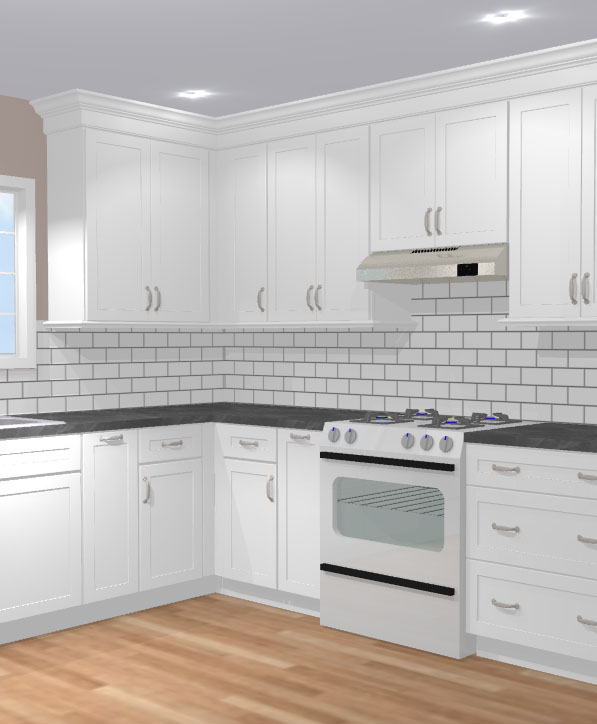
Things to know about this layout option:
- Small kitchen spaces often drive the decision to use an under-cabinet vent hood for space-saving and budget-conscious reasons.
- Cabinets above typically vary in height depending on the hood height and the height of adjacent wall cabinetry. Typical heights range from 18” to 24”.
- Vent Hoods often have a stainless-steel finish and are available as a stock item in stores for pickup. Other finishes may also be offered.
- Controls are often visible on the front of the hood for fan and lighting options.
- Some models of vent hoods allow for the option of installing a recirculating or external venting option. External venting options should be explored in advance to ensure your space is compatible. Otherwise, recirculating is an option.
The dollar signs are used to show a price comparison relative to the cost of the cabinetry and the appliances. Of course, depending on your final choices, cost will vary.
Microwave Vent Hood
$
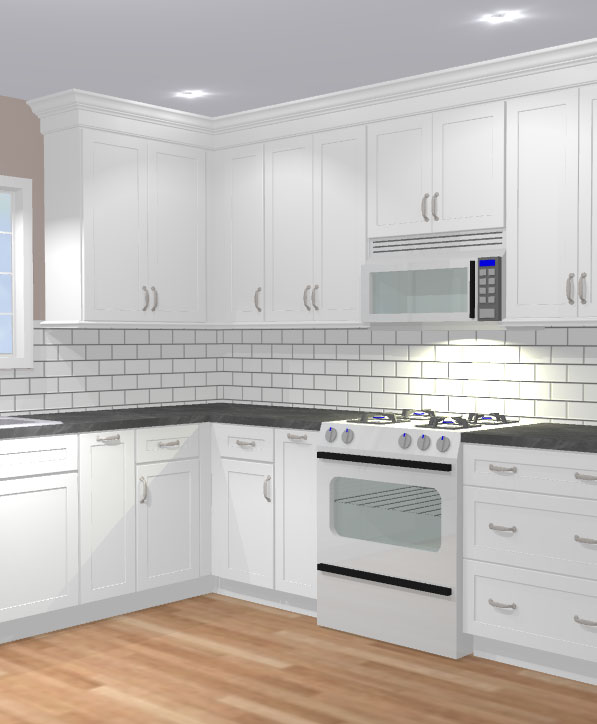
Things to know about this layout option:
- Microwave vent hoods are a good ventilation option for small spaces, featuring both cooking and ventilation while freeing up valuable counter space.
- Cabinets above typically vary in height depending on microwave selection and height of adjacent wall cabinetry. Typical heights range from 15” to 21”. See appliance specs for the appropriate distance between the cooking surface and the microwave.
- The microwave should not drop below the underside of the flanking wall cabinets.
- Typically offered in a stainless-steel finish and available as a stock item in stores for pickup. Other finishes may also be offered.
- Most models of venting microwaves allow for the option of installing a recirculating or external venting system. External venting options should be explored in advance to ensure your space is compatible. Otherwise recirculating is an option.
- KNOW BEFORE YOU BUY – Placing the microwave over the range/cooktop can be a safety hazard for children or even shorter adults. Reaching over a hot range to access the microwave can be dangerous. And, removing hot items from a higher level can be challenging. If you have kids, consider selecting a different location for your microwave. Talk with your designer about options.
Stainless Awning Hood
$$

Things to know about this layout option:
- An awning style hood provides a more decorative and prominent focal point compared to a simple under-cabinet hood or a microwave vent hood.
- Cabinets above typically vary in height depending on the hood height and height of adjacent wall cabinetry. Typical heights range from 12” to 24”. See appliance specs for the appropriate distance between the cooking surface and the vent hood.
- Controls are often hidden to provide a sleek outer appearance.
- Most awning hoods feature powerful venting systems that require external venting. External venting should be explored in advance to ensure your space is compatible. Otherwise, you may need to consider alternate solutions.
- Often a special-order hood. Inquire on timing for order and delivery.
Stainless Steel Chimney Hood
$$

Things to know about this layout option:
- This is a standalone appliance hood, which means no cabinetry is necessary on either side or above.
- Great option when you want a focal point with a tile back splash.
- Often deeper than under-cabinet hoods and requires external ventilation.
- Most models have concealed controls for a streamlined style.
- Available in a variety of shapes, sizes, and materials ranging from all stainless to stainless and glass or even black stainless and more.
- Coordinating blower units are sold separately and provided by the cabinet manufacturer for a perfect fit. These are powerful venting systems that require external venting.
- External venting should be explored in advance to ensure your space is compatible. Otherwise, you may need to consider alternate solutions.
- Depending on the model you choose, it may be a special-order item. You will want to check on timing for order and delivery.
Classic Wood Hood
$$
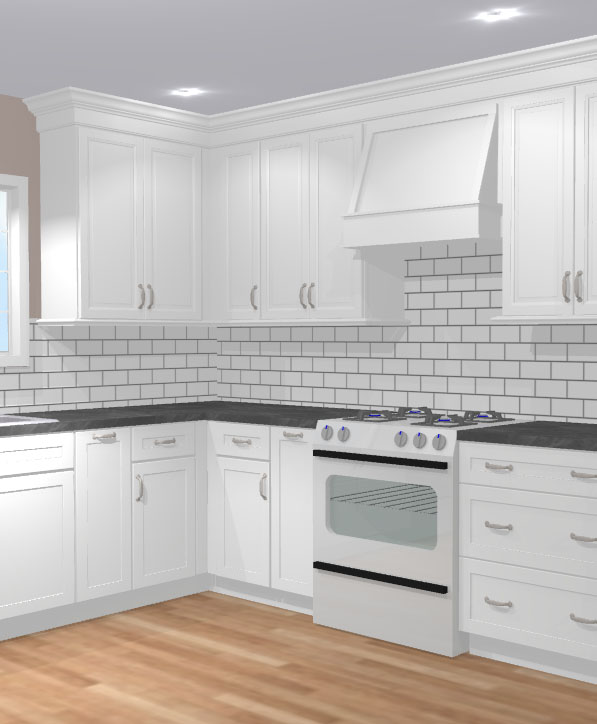
Things to know about this layout option:
- Space saving option for a wood style hood that matches your cabinets. Provides a decorative focal point in the kitchen without breaking the bank.
- Recommended to be designed in the same finish as adjacent cabinetry. Not ideal for an accent color. Freestanding hoods are a better option if you are looking for accent color options.
- Requires wall cabinetry installed on either side and possibly above depending on the selected hood height.
- Controls are hidden to allow the beauty of the hood to stand out.
- Wood hoods are required to be set 30” above the cooking surface. Therefore, adjacent wall cabinetry will sit lower than the bottom of the hood.
- Coordinating blower units are sold separately and provided by the cabinet manufacturer for a perfect fit. These are powerful venting systems that require external venting.
- External venting should be explored in advance to ensure your space is compatible. Otherwise, you may need to consider alternate solutions.
Classic Wood Chimney Hood
$$$
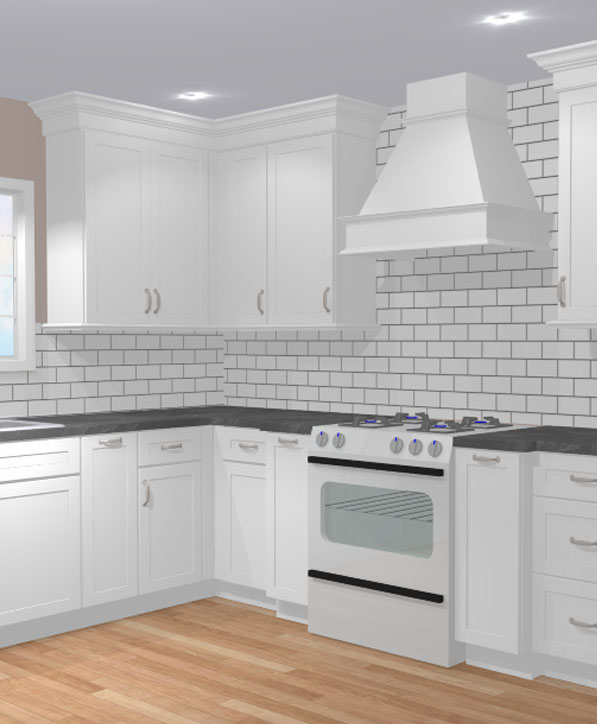
Things to know about this layout option:
- This chimney style hood is designed to stand out as a focal point in your kitchen. It’s a perfect location for that accent color you may be contemplating. This choice provides the look of a higher-end custom cabinetry style without the custom price tag.
- Engineered to stand alone on a wall where adjacent cabinetry is often set to a minimum of 3” away from sides.
- Controls are hidden to allow the beauty of the hood to stand out.
- Wood hoods are required to be set 30” above the cooking surface. Therefore, adjacent wall cabinetry will sit lower than the bottom of the hood.
- These hoods are 19”, 21” or 24” deep, which requires the base cabinetry below to be pulled out from the wall 3”. This adds up to a maximum total of 27” surrounding the cooking range or cooktop. This also means your countertop fabrication will be affected with additional cuts or radius.
- Wood chimney hoods have coordinating blower units sold separately by the cabinet manufacturer for a perfectly coordinated fit. These are powerful venting systems that require external venting.
- External venting should be explored in advance to ensure your space is compatible. Otherwise, you may need to consider alternate solutions.
Box Hood: Connected to wall cabinets
$$$
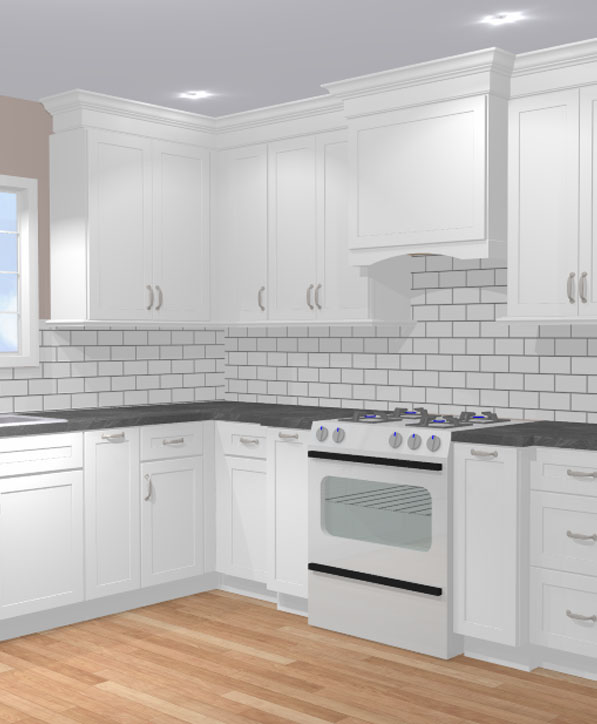
Things to know about this layout option:
- A simple box style hood provides a focal point statement for any style. Recommended to be finished in the same color as the rest of the wall cabinets.
- Controls are hidden to allow the beauty of the hood to stand out.
- Hood is required to be set 30” above the cooking surface. Therefore, adjacent wall cabinetry will sit lower than the bottom of the hood.
- These hoods are 19”, 21” or 24” deep, which requires the base cabinetry below to be pulled out from the wall 3”. This adds up to a maximum total of 27” surrounding the cooking range or cooktop. This also means your countertop fabrication will be affected with additional cuts or radius.
- Box Hoods have coordinating blower units that are sold separately and provided by the cabinet manufacturer for a perfect fit. These are powerful venting systems that require external venting.
- External venting should be explored in advance to ensure your space is compatible. Otherwise, you may need to consider alternate solutions.
Box Wood Hood: Freestanding
$$$
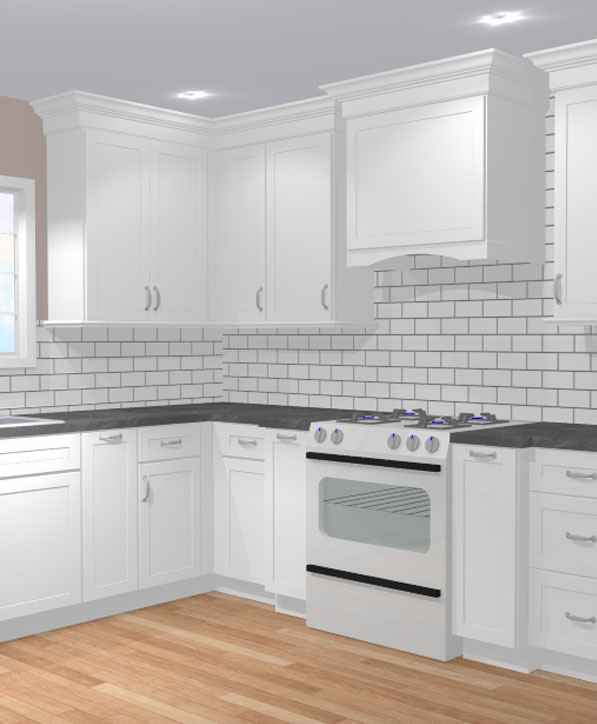
Things to know about this layout option:
- Similar to the previous Box Hood, this layout features the hood free floating from the wall cabinets to create a strong focal point.
- Available with an understated plain front, decorative columns, or valances.
- Comes with the option to be finished in a complementary or accent color. Controls are hidden to allow the beauty of the hood to stand out.
- Wood hoods are required to be set 30” above the cooking surface. Therefore, adjacent wall cabinetry will sit lower than the bottom of the hood.
- These hoods are 19” or 22” deep, which requires the base cabinetry below to be pulled out from the wall 3”. This adds up to a maximum total of 25” surrounding the cooking range or cooktop. This also means your countertop fabrication will be affected with additional cuts or radius.
- Box Hoods have coordinating blower units that are sold separately and provided by the cabinet manufacturer for a perfect fit. These are powerful venting systems that require external venting.
- External venting should be explored in advance to ensure your space is compatible. Otherwise, you may need to consider alternate solutions.
Mantle Style Wood Hood
$$$$$

Things to know about this layout option:
- Mantle hoods are fully integrated into your cabinet design. They are extended all the way down to the counter to provide additional storage and create an alcove design.
- The portion extending down to the counter can be designed with decorative columns. Or, it could be used for pull-out storage to accommodate spices and cooking oils. (Storage option is shown here.)
- Acts as a great focal point when finished in an accent color.
- These hoods are 18” and 21” deep. It is recommended for base cabinets below to be pulled out from the wall 3” for a total of 24” surrounding the cooking range or cooktop. This also means your countertop fabrication will be affected with additional cuts or radius.
- Commonly takes up more than twice the width of the cooking range once clearances are factored in. Recommended for larger kitchens.
- Mantle hoods have coordinating blower units that are sold separately and provided by the cabinet manufacturer for a perfect fit. These are powerful venting systems that require external venting.
- External venting should be explored in advance to ensure your space is compatible. Otherwise, you may need to consider alternate solutions.
